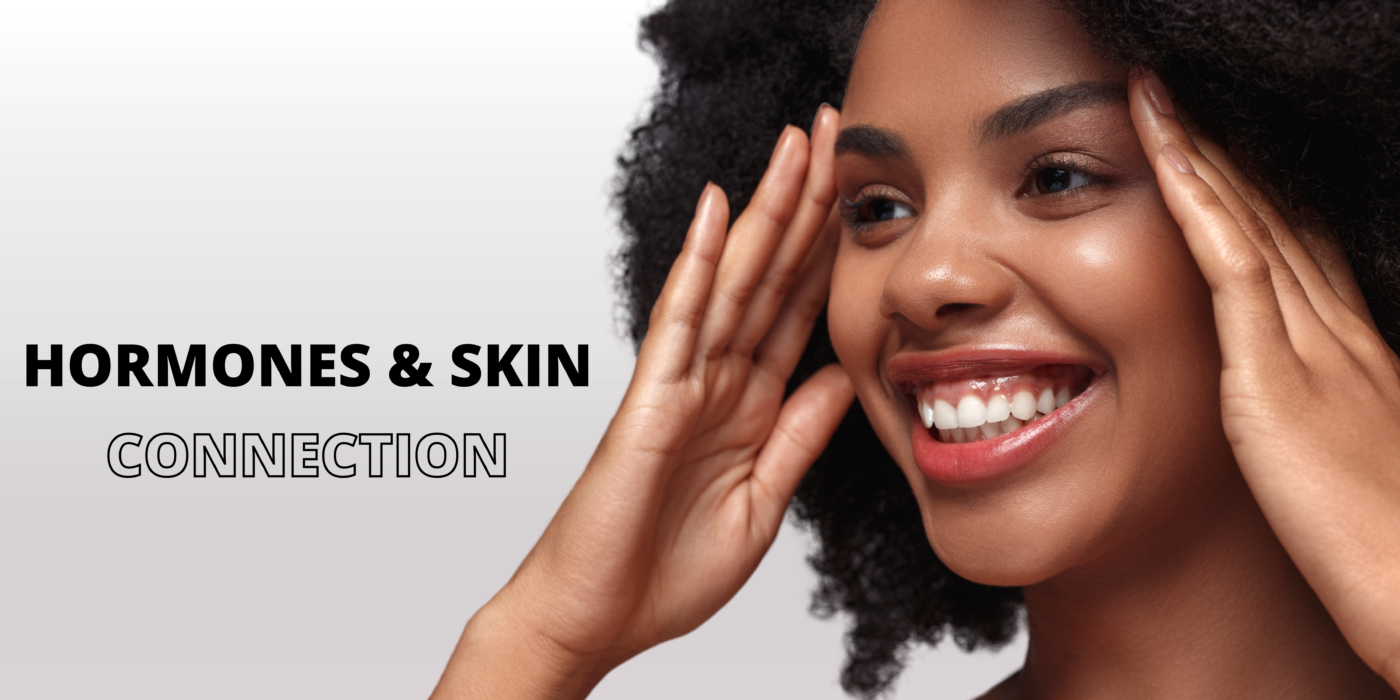How hormones affect our skin
The hormones and skin connection is evident, in-fact, so evident that some of us experience this connection in the form of pimples every month and even use this sudden breakout as a period tracker (even more accurate than menstrual cycle tracking apps these days… are we right? ;p ).
Sudden breakouts during phases of our menstrual cycle are strongly correlated with fluctuations in hormones and skin which are created and controlled by the endocrine glands in our systems. When our bodies experience stress, the hormones affect our skin, endocrine glands get on the grind and release the appropriate hormones into the bloodstream for the body to react and adapt to this response, the results? Excessively oily skin over time, breakouts, eczema and other skin concerns.
It’s crucial to know the effect hormones on skin, so you can play your part in managing stress, making lifestyle changes and treating any imbalances and listening to your body! Here are the four key hormones that cause changes to our skin:
- Estrogen
Estrogen stimulates elastin, collagen, and hyaluronic acid production, which helps the skin stay firm and plump.
- Progesterone
Progesterone stimulates sebum production by the oil glands that causes the skin to swell making the pores appear smaller.
- Testosterone
Testosterone levels rise during menstruation and work similarly to progesterone by activating the sebaceous glands to produce oil.
- Cortisol
High cortisol levels are triggered by chronic stress and cause increased oil production by sebaceous glands, leading to clogged pores and acne breakouts.
Every female goes through 6 critical hormonal life changes… yes, 6- which affects our skin too! Here’s an overview of these hormonal changes:
- Menstrual Cycle
Typically begins around the ages of 10-14. The menstruation cycle consists of 4 phases, including:
- Menstruation
Menstruation is governed tightly by orchestrated changes in the levels of ovarian estrogen and progesterone, which produce varying responses in diverse tissues and organs, including the skin (Farage et al., 2009).
At the beginning of and during menstruation, estrogen and progesterone levels are low. This means there is less sebum production, so our skin becomes dry and dehydrated.
During this time it is vital to keep skin hydrated, moisturised and clean to avoid any infections. Drink adequate amounts of water and eat foods with high water content.
PS: A little sheet masking goes a long way for your skin during menstruation – our personal favourite thing to do at Uncover skincare is alternate between our 3 sheet mask variants beginning with a green tea antioxidant filled “I Am Beau-tea-ful” sheet mask, followed with aloe vera “I Am Cool” sheet mask for period-related hot flashes and finally a brightening dose of vitamin C “I Am Brilliant” in the end days to help reduce the appearance of blemishes from pre-period breakout. Shop Uncover sheet masks here.
- Follicular phase
Typically occurs in the first 10-16 days of the menstrual cycle. Estrogen and testosterone levels start to rise, you know what that means- sebum production is now more normal and skin is more supple, moisturised with higher collagen production.
A minimal skincare routine works perfectly , but don’t skip the moisturiser or sunscreen! We would also recommend using a salicylic acid cleanser to help get rid of any excess oil accumulated in pores. Shop our salicylic acid infused AC clean saver foam cleanser here.
- Ovulation phase
Ovulation begins on day 14 of the menstrual cycle. Testosterone and estrogen levels decrease while progesterone levels increase. In the first few days of the ovulation phase, skin is clear and bright until the last few days of the phase when progesterone levels start to increase causing excess oil production.
Use products that do not clog pores and remember to exfoliate 2-3 times a week to get rid of dead skin cells.
- Luteal phase
The Luteal phase lasts 11-17 days, before menstruation begins and is characterised by high progesterone levels, which basically means your sebaceous glands are on overdrive! Skin becomes oily and the chance of breakouts are high. During this phase, avoid heavy, pore clogging make-up, opt for oil controlling products with Niacinamide- shop here. Drink lots of water and eat vegetables and fibre-rich foods!
- Pregnancy
Estrogen and progesterone levels peak during pregnancy. The peak in these female hormones causes melasma (referred to as chloasma during pregnancy)- an overproduction of melanin, which increases hyperpigmentation, darkening of nipples, moles and vulva.
It’s important to note that chloasma/skin hyperpigmentation doesn’t cause any harm to the mother or baby – but does become a skin hyperpigmentation concern. Well, the good news is that hormones and skin hyperpigmentation can be controlled! Here’s how- limit sun exposure, protect your skin by applying pregnancy-safe sunscreen daily (SPF 30+ please) and use pregnancy safe ingredients such as Vitamin C or Niacinamide to reduce hyperpigmentation.
Shop our pregnancy safe Vitamin C sheet masks and Niacinamide 10 brightening ampoule here.
PS: After giving birth, the darker patches should fade within three months. If the condition still persists, do consult a dermatologist!
- Postpartum – after birth
Estrogen levels decrease significantly after delivery. These hormonal fluctuations can manifest on the skin in different ways, for instance, you could begin to break out a lot more or your skin could even become increasingly dry and cracked- phew, the power of hormones.
You can expect a more balanced hormonal response after breastfeeding ceases and your normal menstruation cycle begins again.
If you experience increased breakouts – opt for this Niacinamide 10 brightening ampoule.
- Perimenopause
You may have heard of menopause hormonal fluctuations, but have you heard of the changes during perimenopause ? Perimenopause is actually the period before menopause. During this time, estrogen levels fluctuate, the ovaries begin to produce less estrogen causing overall ageing of the skin, dullness, lack of elasticity, and for some women may result in a skin condition known as rosacea- a chronic inflammatory skin disease characterized by pustules, pimples, flushing, redness, and dilated blood vessels.
Fluctuating estrogen levels during this period also affect lymphatic circulation- and a decrease in lymphatic health contributes to the appearance of cellulite!
Note to self- estrogen is skin health baby – in balance of course.
- Menopause
Estrogen levels drop significantly during menopause! Collagen production decreases resulting in facial sagging, reduced skin thickness, facial volume loss, and wrinkles! Infact, research indicates that women lose about 30% of collagen during the first five years of menopause.
But again, there’s ways to get your collagen in check- take supplements, eat foods rich in collagen eg fish, chicken, and egg whites. Use skincare products with retinol or peptides which help stimulate collagen production and reduce wrinkles! Shop our Uncover skincare, Cica peptide repair serum here.
Take care of your skin, and keep it moisturised and hydrated- we recommend our Squalane Desertica moisture cream with antioxidant properties and anti-ageing benefits of squalane – shop now. Remember to follow up with sunscreen SPF 30+ daily to protect your skin from the harmful effects of UV rays.
- Post menopause
This is it ladies, one last straw- during post-menopause, women lose on average, 2.1% of skin collagen per year over 20 years!
Skin becomes drier and less elastic during this period resulting in thinner, wrinkled tissue from collagen loss. The skin is also more prone to damage. Sagging also occurs on the jaws, neck, and eyes – giving skin a droopy appearance.
The decrease in female hormone- estrogen increases these undesired, ageing effects.
Guys embrace, love and listen to your skin, it acts as a communication centre for our hormones. Have you experienced any hormones and skin hyperpigmentation changes? Let us know in the comments below.

